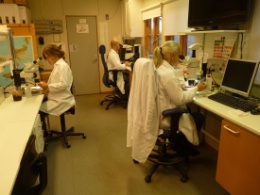Sorting procedures and taxonomic units
The ultimate goal of the SMTP is to process every single specimen caught in the trapping campaign, and to make the material available on demand to taxonomic experts. Collecting millions of insects is an achievement in itself, but the SMTP has successfully managed the far greater challenging tasks of pre-sorting (involving identification to a certain taxonomic level), curation, and safe storage of the specimens collected. Since 2007, SMTP has developed a unique know-how of the handling and sorting of bulk insect samples into units that can be managed by, and are thus appealing to, collaborating taxonomists.Over the years, the sorting process has become increasingly streamlined. Sorters, frequently volunteers, are selected carefully and trained as appropriate. Identification manuals have been developed to quickly bring new sorters up to speed.
The labeling process has been largely automatized, the storing system standardized, and the database is being integrated with the web-based collection management software (DINA-SPECIFY) currently being developed by a consortium of international natural history museums.The most significant resource developed by SMTP over the years is its cadre of sorters (parataxonomists), which need to be both skilled in the lab and knowledgeable in insect taxonomy. Strict training and lab rules make sure that each single specimen will end up in the right vial. At the same time, it is the high precision of the pre-sorting that makes SMTP material so attractive and outstanding when compared with the incalculable amount of unidentified specimens deposited in entomological collections around the world.
SMTP ´s sorting process is performed in three consecutive steps, in which bulk samples are eventually sorted into 330 different taxonomic entities. In the first-tier sorting, a bulk sample is split into 35 different insect orders, suborders or comparable units. In a second tier, Hymenoptera, Diptera: “Nematocera”, Diptera: Brachycera and Araneae are sorted mainly to the level of family, which is the category usually mastered by a single taxonomic expert. In a third tier, various subgroups of Hymenoptera are sorted into manageable units, such as the superfamily Chalcidoidea into families, and the families Ichneumonidae and Braconidae into subfamilies, tribes, or even genera.
Fractions in SMTP-overview and availability
SMTP samples are thus available upon request. We are very grateful for any help in identification, also among trivial, species-poor, or non-target groups. Beside the obvious importance for systematical studies in more or less poorly known groups, and for Swedish insect faunistics the whole, it is also a rich material for both systematical and ecological biodiversity studies and various other biological questions. We encourage all kinds of specialists in particular groups (both professionals and amateurs) as well as interested students to contact us about groups of interest. Student projects can be carried out at the student’s own institution with borrowed material (if proper supervision is available) or preferably whilst staying at the research station on Öland, supervised by project staff onsite.In the menu on the left-hand side you can find links which present a snapshot of the fractions and the availability in each taxon June 1st 2015. An updated overview of sorting status is available at naturarv.se, and later detailed information about all identified specimens will be available on mentioned site. Until then, detailed information will be obtained on request from the SMTP staff.
Remarks For each taxon the total number of known species in Sweden are given in parentheses (including accidentals). Taxa considered non-monophyletic are in quotes. Note that the classification given here is not necessarily a state-of-the-art valid classification in all details, but represent the actual units in SMTP sorting.
The data on the following links are compiled by Mattias Forshage, SMTP
Page lay-out, pictures and text by Dave Karlsson, SMTP

Sorting in progress at the SMTP-lab. To the left Kajsa Glemhorn (first tier sorting), to the right Nino Petersson (first tier sorting) and Pelle Magnusson (Hymenoptera guru).

Sorting education in progress. Here Kajsa teaches Annie the noble art of insect sorting.

The sorted insects are mid-stored in a transit room before they are moved to Station Linnes storage or sent away to taxonomic expertise all around the world.